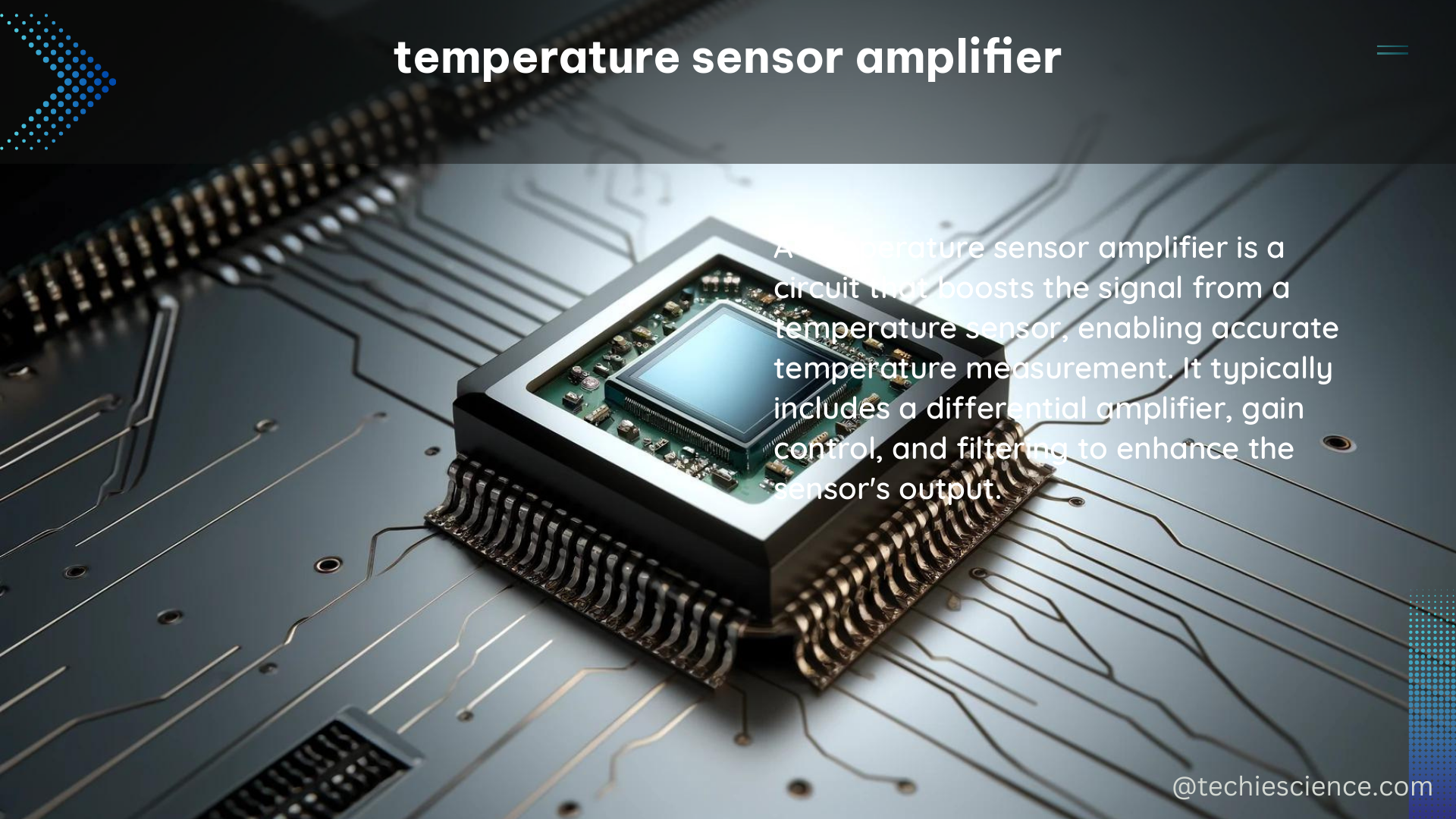Temperature sensor amplifiers are critical components in temperature measurement systems, responsible for amplifying the small electrical signals generated by temperature sensors such as thermocouples, RTDs, and thermistors. These amplifiers ensure that the signals can be accurately measured and processed by data acquisition systems or control systems. In this comprehensive guide, we will delve into the technical specifications, features, and best practices for using temperature sensor amplifiers.
Understanding the Technical Specifications
The technical specifications of a temperature sensor amplifier can vary depending on the manufacturer and model, but there are several key parameters to consider:
Gain
Gain is the ratio of the output voltage to the input voltage, and it is usually expressed in decibels (dB). A higher gain value means the amplifier can amplify the input signal more, which is essential for accurately measuring small temperature changes.
Input Impedance
Input impedance is the resistance that the amplifier presents to the temperature sensor. It should be high enough (typically in the range of megohms) to avoid loading the sensor and affecting the measurement.
Output Impedance
Output impedance is the resistance that the amplifier presents to the data acquisition system or control system. It should be low enough (typically in the range of ohms) to ensure proper signal transmission and minimize signal distortion.
Bandwidth
Bandwidth is the frequency range over which the amplifier can accurately amplify the signal, and it is usually specified in Hertz (Hz). A wider bandwidth allows the amplifier to handle faster temperature changes.
Noise Level
Noise level is the amount of unwanted electrical signals generated by the amplifier, and it is usually expressed in volts (V) or nanovolts (nV). Lower noise levels are desirable for accurate temperature measurements.
Common-Mode Rejection Ratio (CMRR)
CMRR is the ability of the amplifier to reject common-mode signals, such as electrical noise. It is usually expressed in decibels (dB), and a higher CMRR value indicates better noise rejection.
Power Supply Requirements
Power supply requirements include the voltage and current needed to operate the amplifier. Ensuring the correct power supply is essential for proper amplifier function.
Temperature Range
Temperature range is the range of temperatures over which the amplifier can operate accurately, and it is usually specified in degrees Celsius (°C) or Kelvin (K).
Exploring the TBR4100/1025 Temperature Sensor Amplifier

To illustrate these technical specifications, let’s take a closer look at the TBR4100/1025 temperature sensor amplifier from World Precision Instruments:
| Specification | Value |
|---|---|
| Gain Range | 1 to 10,000 |
| Input Impedance | 10 MΩ |
| Output Impedance | 50 Ω |
| Bandwidth | 100 kHz |
| Noise Level | 1 nV/√Hz |
| Common-Mode Rejection Ratio | 80 dB |
| Power Supply Requirements | ±5 V |
| Temperature Range | -20°C to 50°C |
In addition to these specifications, the TBR4100/1025 amplifier also features:
- Total galvanic isolation of channel inputs, which helps to eliminate ground loops and improve signal integrity.
- Pre-adjusted selectable Poise voltage values for each type of sensor, simplifying setup and configuration.
- Front panel mounted digital panel meters to monitor Poise voltage and sensor, providing real-time feedback.
- Front panel input connectors designed to provide easy connection to any standard data recording device.
Proper Setup and Calibration
To ensure the best performance of the temperature sensor amplifier, it is essential to follow proper setup and calibration procedures. For the TBR4100/1025 amplifier, this includes:
- Calibrating the amplifier using the LabScribe software and a pre-calibrated temperature input.
- Allowing the sensors to stabilize before calibration to ensure accurate measurements.
- Setting the appropriate range for the application to optimize the amplifier’s performance and avoid signal clipping or saturation.
By understanding and properly configuring the technical specifications and features of the temperature sensor amplifier, you can ensure accurate and reliable temperature measurements in a wide range of applications, from industrial process control to scientific research.
Conclusion
Temperature sensor amplifiers are essential components in temperature measurement systems, and their technical specifications and performance characteristics should be carefully considered when selecting and using these devices. By understanding the key parameters, such as gain, input and output impedance, bandwidth, noise level, common-mode rejection ratio, power supply requirements, and temperature range, you can ensure accurate and reliable temperature measurements in your applications.
References:
– TBR4100/1025 – World Precision Instruments, https://www.wpiinc.com/media/wysiwyg/pdf/TBR_IM.pdf
– Temperature Measurement and Control Catalog – Lake Shore Cryotronics, https://www.lakeshore.com/docs/default-source/product-downloads/lakeshoretc_l.pdf
– Goddard Technical Standard GSFC-STD-7000B – NASA, https://standards.nasa.gov/sites/default/files/standards/GSFC/B/0/gsfc-std-7000b_signature_cycle_04_28_2021_fixed_links.pdf
– Control Valve Handbook – Emerson, https://www.emerson.com/documents/automation/control-valve-handbook-en-3661206.pdf

The lambdageeks.com Core SME Team is a group of experienced subject matter experts from diverse scientific and technical fields including Physics, Chemistry, Technology,Electronics & Electrical Engineering, Automotive, Mechanical Engineering. Our team collaborates to create high-quality, well-researched articles on a wide range of science and technology topics for the lambdageeks.com website.
All Our Senior SME are having more than 7 Years of experience in the respective fields . They are either Working Industry Professionals or assocaited With different Universities. Refer Our Authors Page to get to know About our Core SMEs.